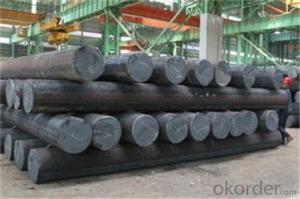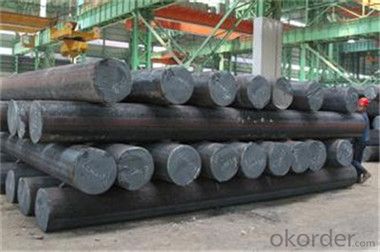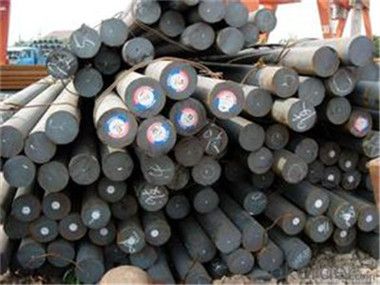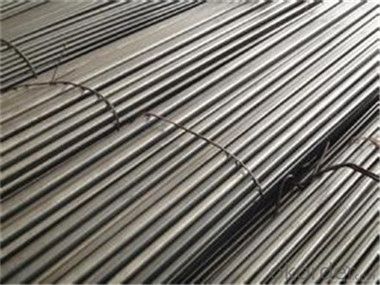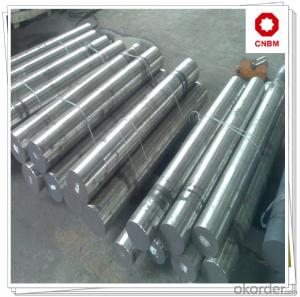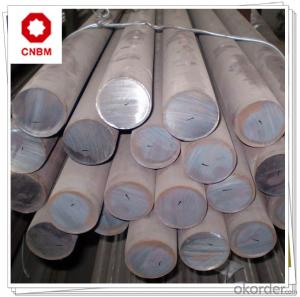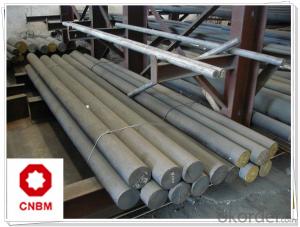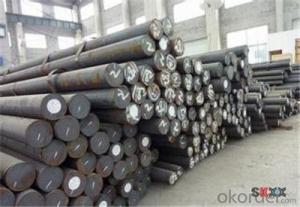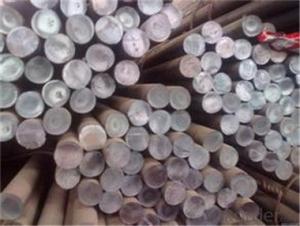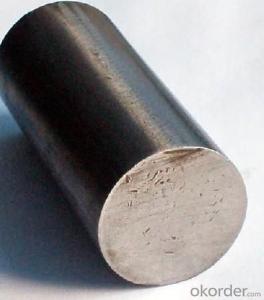Steel Round Bar Reliable Manufacturers from China
- Loading Port:
- Tianjin
- Payment Terms:
- TT OR LC
- Min Order Qty:
- 554 m.t.
- Supply Capability:
- 2000000 m.t./month
OKorder Service Pledge
OKorder Financial Service
You Might Also Like
Description of steel round bar:
1. Commodity: Round steel bar
3. Technical: Hot rolling
2. Length: Min. 5.8meter, according to requirement.
3. Diameter: 16mm-250mm
Festures of steel round bar:
1.Dia 80-800mm Length:2000-13000mm or as required
2.Technique:Forged
3.Delivery Time:45 days
Specifications of steel round bar:
1. Standards: AISI 4340 8620 8640 4320 , JIS SNCM8 GB:40CrNiMoA
2. Specification: Dia: 80~450mm Length:2000-13000mm or as required
The highest temperature is 427 degrees Celsius.it has good strength,and high quenching property ,the toughness is good and small deformation during quenching.At high temperature.
C | Si | Mn | S | P | Cr | Ni | Cu | Mo |
0.37-0.44 | 0.17-0.37 | 0.40-0.80 | 0.025(max) | 0.025(max) | 0.60-0.90 | 1.25-1.65 | 0.025(max) | 0.15-0.25 |
Images of steel round bar:
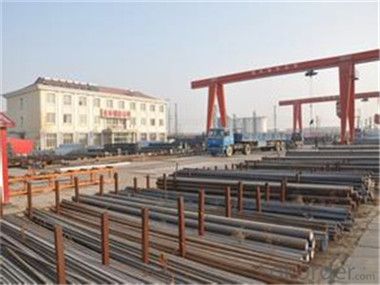
FAQ:
1. What is your package?
Packing situation: standard seaworthy packing or as customer required.
2. How long is the lead time?
Delivery time: 45 days after order confirmed.
3. What payment term do you accept?
Payment: T/T or L/C at sight.
- Q: What are the advantages of using tin-alloy steel round bars?
- There are several advantages to using tin-alloy steel round bars: 1. Enhanced corrosion resistance: Tin-alloy steel round bars have excellent corrosion resistance properties due to the presence of tin. This makes them suitable for various applications in industries such as marine, automotive, and construction, where exposure to moisture, chemicals, or harsh environments is common. 2. Improved machinability: Tin-alloy steel round bars are known for their superior machinability. The addition of tin to the steel composition enhances its ability to be cut, drilled, and shaped more easily, reducing tool wear and increasing productivity during machining processes. 3. Increased strength and durability: The alloying of tin with steel enhances its strength and durability. Tin-alloy steel round bars have higher tensile strength and hardness compared to regular steel bars, making them more resistant to wear, deformation, and fatigue. This makes them suitable for heavy-duty applications and ensures longevity. 4. Excellent thermal conductivity: Tin-alloy steel round bars exhibit excellent thermal conductivity properties. This makes them ideal for applications that require efficient heat transfer, such as heat exchangers, radiators, and engine components. 5. Lower friction coefficient: Tin-alloy steel round bars have a lower friction coefficient compared to regular steel bars. This feature makes them suitable for applications where minimizing friction is crucial, such as in bearings, shafts, and gears, resulting in reduced energy consumption and increased operational efficiency. 6. Cost-effective alternative: Tin-alloy steel round bars offer a cost-effective alternative to more expensive materials such as stainless steel or brass. They provide similar performance characteristics at a lower price point, making them a viable choice for various applications without compromising on quality. In summary, the advantages of using tin-alloy steel round bars include enhanced corrosion resistance, improved machinability, increased strength and durability, excellent thermal conductivity, lower friction coefficient, and cost-effectiveness. These properties make them a versatile and reliable choice for a wide range of applications across different industries.
- Q: What are the different types of steel round bar surface defects?
- Steel round bars can exhibit various types of surface defects. Among the most common defects are: 1. Scale: This defect arises from the formation of a thin layer of oxide on the steel's surface during manufacturing. It presents as a rough, flaky, or scaly texture and can be easily eliminated through pickling or abrasive cleaning. 2. Pitting: Localized corrosion manifests as small, shallow holes or depressions on the steel's surface. It is usually caused by exposure to corrosive substances or environments and can weaken the material if left unaddressed. 3. Surface cracks: These visible cracks appear on the surface of the steel round bar and can be attributed to factors like improper cooling during manufacturing, excessive stress, or mishandling. Surface cracks can compromise the steel's structural integrity and necessitate careful inspection and repair. 4. Decarburization: This defect occurs when the steel's surface layer loses carbon content, resulting in reduced hardness and strength. High temperatures during heat treatment or inadequate cooling methods often cause decarburization. It can be identified through visual inspection or hardness tests. 5. Lamination: Lamination defects arise when layers or flakes are present within the steel round bar. These layers can weaken the material and compromise its structural integrity. Improper rolling or excessive impurities in the steel are typically responsible for lamination defects. 6. Inclusions: During the manufacturing process, foreign materials or impurities can become trapped within the steel, resulting in inclusions. These can appear as dark spots, streaks, or irregular shapes on the round bar's surface. Inclusions reduce the steel's strength and ductility and can be caused by factors such as poor raw material quality or insufficient refining processes. It is crucial to note that the severity and impact of surface defects on steel round bars can vary. Regular inspection and quality control measures are essential for identifying and rectifying any surface defects, ensuring the reliability and integrity of the steel round bar.
- Q: What are the advantages of using chromium-vanadium alloy steel round bars?
- Some advantages of using chromium-vanadium alloy steel round bars include: 1. High strength and toughness: Chromium-vanadium alloy steel has excellent strength and toughness properties, making it suitable for applications requiring durability and resistance to wear and tear. 2. Improved corrosion resistance: The addition of chromium enhances the alloy's corrosion resistance, making it resistant to rust and other forms of corrosion, even in harsh environments. 3. Enhanced hardenability: Chromium-vanadium alloy steel can be easily heat-treated to achieve high hardness levels, allowing for increased wear resistance and improved overall performance. 4. Good machinability: The alloy steel round bars can be easily machined and fabricated, making them convenient to work with in various manufacturing processes. 5. Cost-effective: Chromium-vanadium alloy steel offers a good balance between performance and cost, making it a cost-effective choice for many applications compared to other high-performance alloys.
- Q: What is the difference between a centerless ground and a precision ground steel round bar?
- A centerless ground steel round bar is manufactured by grinding the outer diameter of the bar using a centerless grinding machine. This process ensures that the bar has a consistent diameter throughout its length, with tight tolerances for dimensional accuracy. On the other hand, a precision ground steel round bar is typically manufactured using a different grinding method where the bar is held between centers and ground to achieve precise dimensions and surface finish. This process allows for even tighter tolerances and finer surface finishes than centerless grinding. In summary, while both centerless ground and precision ground steel round bars offer dimensional accuracy, the precision ground bar provides even tighter tolerances and superior surface finish due to the use of a different grinding method.
- Q: What is the impact strength of a steel round bar?
- The impact strength of a steel round bar refers to its ability to withstand sudden forces or shocks without breaking or fracturing. It is a measure of the material's toughness and resistance to impact loads. The impact strength of a steel round bar is influenced by various factors such as the composition of the steel, its heat treatment, and any additional alloying elements. The impact strength is typically determined through testing, such as the Charpy or Izod impact test, which involves striking a notched sample of the steel bar with a pendulum and measuring the amount of energy absorbed by the material before it fractures. The results are usually reported in terms of the energy absorbed in joules (J) or foot-pounds (ft-lb). The impact strength of a steel round bar can vary greatly depending on its grade or specification. Different grades of steel have different levels of toughness, with some being more suitable for applications requiring high impact resistance, such as construction, automotive, or heavy machinery, while others may be better suited for less demanding applications. It is important to note that the impact strength is just one of the many mechanical properties that need to be considered when selecting a steel round bar for a specific application. Other factors, such as tensile strength, yield strength, hardness, and corrosion resistance, should also be taken into account to ensure the optimal performance and durability of the steel round bar in its intended use.
- Q: Can steel round bars be used in structural applications?
- Steel round bars are suitable for structural applications and commonly utilized in construction and engineering projects that prioritize strength and durability. They offer versatility and can function as beams, columns, and supports for various structural elements. Thanks to their exceptional mechanical properties, such as high tensile strength and good ductility, they can withstand heavy loads and resist deformation effectively. Moreover, their easy joinability to other structural components contributes to their popularity within the construction industry.
- Q: What are the different types of steel used for round bars?
- There are several different types of steel used for round bars, including carbon steel, alloy steel, stainless steel, and tool steel. Each type has its own unique composition and properties, making them suitable for various applications and industries.
- Q: How are steel round bars made?
- Hot rolling is the method used to produce steel round bars. It starts by heating a large rectangular steel billet until it becomes malleable. Then, the heated billet is fed through a series of rolling stands that gradually decrease its thickness and give it a round shape. To begin the hot rolling process, the billet is placed in a furnace and subjected to extremely high temperatures, typically ranging from 1200 to 1300 degrees Celsius. This high heat makes the steel more pliable and easier to manipulate. Once the billet is heated, it is introduced into a rolling mill. This mill consists of rollers that progressively reduce the thickness and elongate the billet. Each set of rollers squeezes and stretches the billet, gradually forming it into a round shape. The number of passes through the rolling mill depends on the desired final size and shape of the round bar. While the rolling process takes place, the steel bar is also cooled to prevent overheating and ensure proper metallurgical properties. This cooling can be achieved through the use of a water spray or air cooling system. After the bar has been shaped and cooled, it is cut into the desired lengths. The cut bars then undergo further processes, including straightening, surface treatment, and quality testing. These additional steps guarantee that the steel round bars meet the required specifications and standards. In conclusion, the production of steel round bars involves heating a steel billet, passing it through a series of rolling stands to shape it into a round bar, cooling it, and cutting it into the desired lengths. This process enables the creation of robust and long-lasting round bars that serve various applications in industries like construction, manufacturing, and engineering.
- Q: What are the different types of defects that can occur in steel round bars?
- There are several types of defects that can occur in steel round bars. These defects can vary in their severity and impact on the overall quality and performance of the bars. Some of the common types of defects found in steel round bars include: 1. Surface defects: These defects are visible on the external surface of the bar and can include scratches, pits, and scaling. While surface defects may not affect the structural integrity of the bar, they can impact its aesthetic appeal and can potentially lead to corrosion if not properly addressed. 2. Internal defects: Internal defects are imperfections that occur within the body of the steel round bar. These defects can include voids, inclusions, and segregation. Internal defects can weaken the bar's mechanical properties and compromise its structural integrity. They can also lead to cracking or failure under stress. 3. Dimensional defects: Dimensional defects refer to variations in the size or shape of the steel round bar. These defects can occur during the manufacturing process and can include variations in diameter, length, or straightness. Dimensional defects can affect the bar's functionality and compatibility with other components in a structure or machinery. 4. Decarburization: Decarburization is a defect that occurs when the surface layer of the steel round bar loses carbon due to exposure to high temperatures during manufacturing or heat treatment processes. This defect can weaken the bar's hardness and strength, making it more susceptible to wear, fatigue, or failure. 5. Lamination: Lamination defects occur when there are layers or separations within the steel round bar. These defects can result from improper rolling or processing techniques. Lamination defects can reduce the bar's strength and ductility, making it prone to fracture or failure. 6. Incomplete heat treatment: Heat treatment is often used to enhance the mechanical properties of steel round bars. However, if the heat treatment process is not performed correctly or if there are inconsistencies in the cooling or reheating process, the bar may have incomplete or uneven heat treatment. This can result in variations in hardness, strength, or toughness along the length of the bar. It is important to note that the severity and impact of these defects can vary depending on the specific application and requirements of the steel round bar. Manufacturers and quality control teams employ various testing and inspection methods to detect and mitigate these defects, ensuring that the bars meet the necessary standards and specifications.
- Q: Which steel wire is the same diameter as round steel more resistant to breaking?
- The same diameter wire rope and round steel, steel wire rope is more resistant to break.
Send your message to us
Steel Round Bar Reliable Manufacturers from China
- Loading Port:
- Tianjin
- Payment Terms:
- TT OR LC
- Min Order Qty:
- 554 m.t.
- Supply Capability:
- 2000000 m.t./month
OKorder Service Pledge
OKorder Financial Service
Similar products
Hot products
Hot Searches
Related keywords
